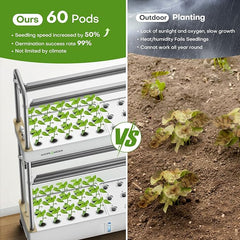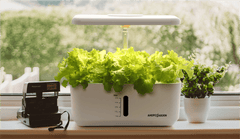In recent years, getting a vertical indoor hydroponic garden has emerged as a sustainable solution to address the challenges of traditional farming methods. With limited space and a growing demand for fresh produce, vertical farming offers a promising alternative by maximizing yields in compact environments. However, the success of vertical farming hinges on selecting the right crops that thrive in these controlled conditions. In this in-depth exploration, we delve into the intricacies of vertical indoor hydroponic gardening and identify the best crop suited for this innovative agricultural practice.

Vertical indoor hydroponic gardening revolutionizes traditional farming by cultivating crops in stacked layers, utilizing controlled environments, and employing hydroponic systems to deliver nutrients directly to plant roots. This method eliminates the need for soil, conserves water, and minimizes the risk of pests and diseases, making it an attractive option for urban agriculture and sustainable food production.
When determining the best crop for your vertical indoor hydroponic garden, several factors must be considered. These include growth characteristics, nutritional requirements, space efficiency, and market demand. While a wide range of crops can be cultivated using vertical farming techniques, certain varieties excel in this environment and offer optimal yields and quality.
Leafy greens, such as lettuce, spinach, and kale, stand out as top contenders for vertical indoor hydroponic gardens. These fast-growing crops have shallow root systems, making them well-suited for vertical stacking and efficient nutrient uptake. Additionally, leafy greens have high market demand, making them economically viable choices for vertical farming operations.
Herbs, including basil, mint, and cilantro, are also excellent candidates for vertical indoor hydroponic gardens. With their compact growth habit and intense flavors, herbs thrive in controlled environments and provide a continuous harvest throughout the growing season. Moreover, herbs command premium prices in the market, offering lucrative opportunities for vertical farmers.
Strawberries represent another promising crop for vertical indoor hydroponic gardens. These perennial fruits can be grown year-round in stacked towers, utilizing vertical space efficiently. By providing optimal growing conditions, such as temperature, humidity, and light intensity, vertical farmers can achieve high yields of sweet and succulent strawberries, catering to consumer preferences for fresh and locally grown produce.

In addition to leafy greens, herbs, and strawberries, other crops, such as microgreens, cherry tomatoes, and peppers, demonstrate potential for a vertical indoor hydroponic garden. By experimenting with different crop varieties and optimizing growing conditions, vertical farmers can diversify their production and capitalize on niche markets, further enhancing the sustainability and profitability of their operations.
In conclusion, the best crop for vertical indoor hydroponic gardens depends on various factors, including growth characteristics, nutritional requirements, space efficiency, and market demand. While leafy greens, herbs, and strawberries emerge as frontrunners for vertical farming, the potential for cultivating other crops in this innovative agricultural system is vast. By harnessing the power of vertical farming, we can revolutionize food production, mitigate environmental impacts, and create a more resilient and sustainable food system for future generations.
For those who want green and healthy food for their family's table, try Ahope indoor smart garden system to grow anywhere and anytime.


